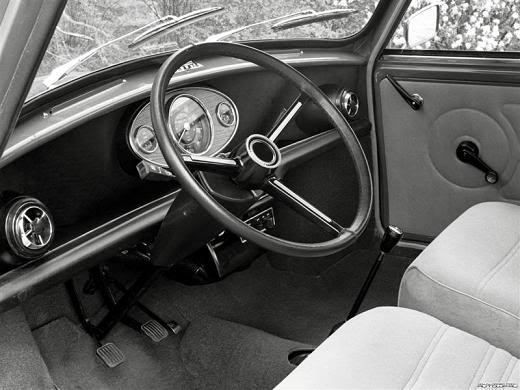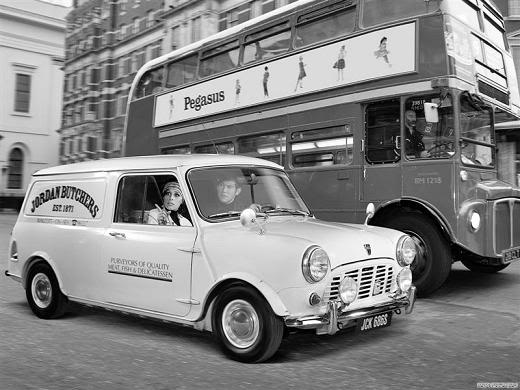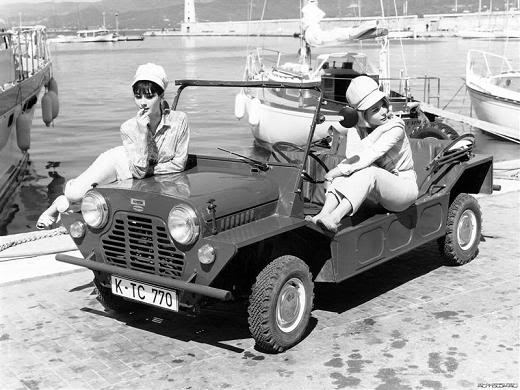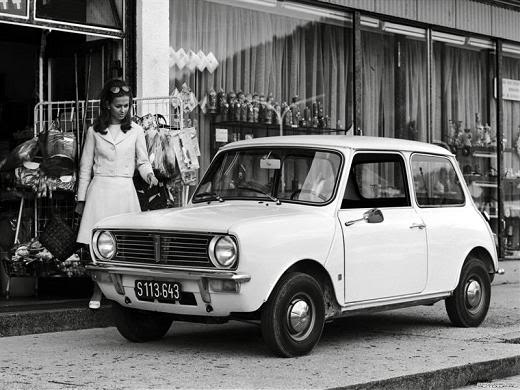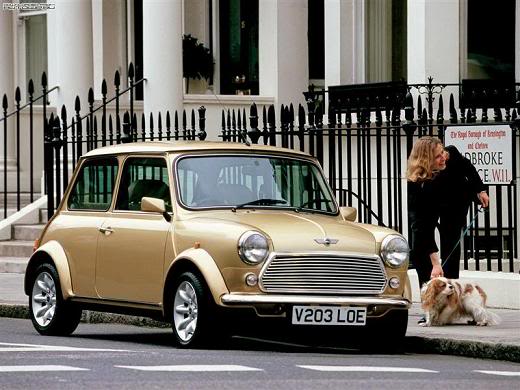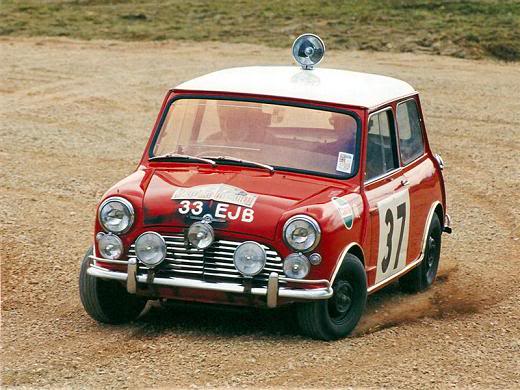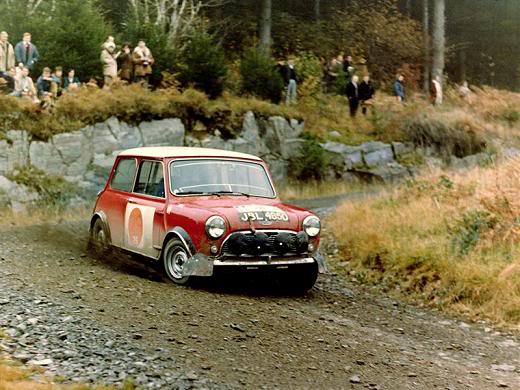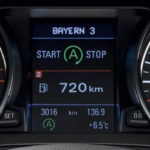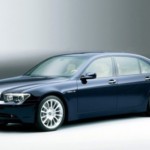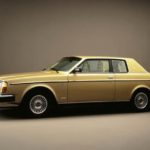Mini 1959 - 2000 - Model History
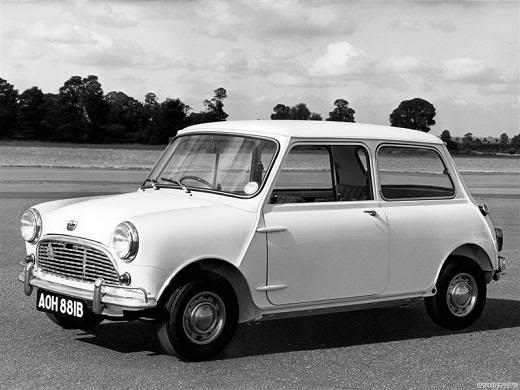
Mini
Although motoring was started by expensive, rare and unmanageable machines, small, cheap and affordable cars maintained and developed it to an unprecedented scale.
Ever since the advent of Ford T, a class of cheap cars for the widest possible audience has been created with the task of motorizing the world. Their role was great from the beginning, but they became the most significant after the Second World War. Namely, in those years every national industry, that is, every car factory had one “low budget” model that animated the widest circle of customers. The most famous cars of these classes soon became legends, and so France had Citroen 2CV ("Spaček") and Renault Dauphine, Italy, the famous Fiat Topolino, later the Model 500 ("Fiča"), Germany, of course, VW Bubu, while England had no real competitor, if you count, Morris Minor, who still wasn't. in that class. The Suez crisis, the second half of the XNUMXs, shook the world, especially the United Kingdom, which suddenly found itself in a major fuel shortage. Faced with the new situation, manufacturers have turned to various, sometimes ridiculous, alternatives, such as three-wheelers or small-engine models and low power. At that moment, the giant BMC (British Motor Corporation) started a small vehicle project that would have all the features of larger cars, but with low power consumption and maximum usability. A difficult task, but the management of the company was confident, if entrusted to experienced engineer Alec Issigonis, that a satisfactory solution would be found.
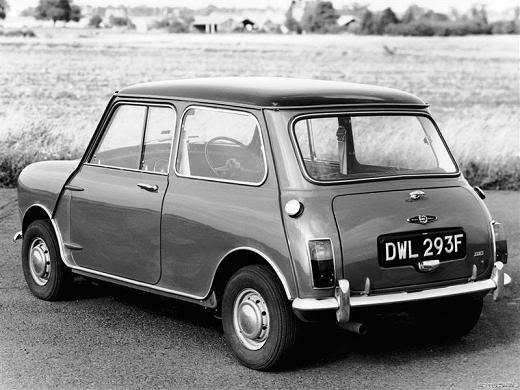
Mini
Alek Issigonis (naturalized Englishman of Greek descent, born in Turkey in 1906) was a well-known expert, then employed by Alvis, and during his long career he designed many BMC models. By coincidence, regardless of the corporation's invitation, Issigonis worked on a similar project that should completely break with the previous tradition of making compact vehicles. Initially, this engineer refused to take over the development, but with the assurances of Sir Leonard Lord, the BMC project manager, that he would have his hands completely restrained, he finally agreed. In 1957, the development officially began, and the very next year, in 1958, a new model, then unnamed, took on a recognizable shape. Issigonis created a radically different car than what could be seen on the streets in those years. To begin with, the engine was positioned forward, transversely (transversely) transmitting power to the front wheels while the transmission was positioned below the engine, saving space. Inside, there was room for four people with a very modest trunk. By the end of 1958, the prototype was ready and at that time the name Mini came into informal use. Simply with dimensions of 3.05 (length), 1.41 (width) and 1.35 meters (height) it was the only logical name. Sir Leonard Lord, after only 5 minutes of test driving, delighted with the features, orders the prototype to finish as quickly as possible and start production.
The official premiere of the new BMC model was on August 26, 1959. The audience was very intrigued by the appearance of the Austin Mini Seven and Morris Mini Minor (initially sold under both names) especially its published price of just £ 496, which was incredibly small compared to all the other models that made him a competitor. However, in terms of technology, the Mini had no competitors because at the time of presentation was far more modern than the Beetle, Spachek or Fiat 500. Below the hood was the famous BMC engine of 850ccm with 34 hp, although at first glance deminutive, this unit provided the Mini excellent performance, thanks to the light weight of the vehicle (600 kg), so all the specimens were very agile and starting, which is a feature that has adorned these models throughout the years of production. Instantly, the Mini has received a good response from the market, which at first was even a little suspicious of this model but thanks to its low price and very positive reviews, its popularity grew. However, these first specimens were very spartanly equipped, so the windows were sliding, a cabin without any luxury with a centrally mounted speedometer, there was no lever to close the door from the inside, but the role was played by a stretched rope and traces of rivets and welding were visible on the body. . Issigonis (an avid smoker) designed the ashtray but left no room for the installation of radios, which could not be obtained in the Mini for a long time.
Still, the Mini also had a dark side and that was security. Due to its dimensions, it always "pulled out the thick end" in accidents, and the front seats did not have a fixing mechanism, so they "fired" passengers like a catapult in frontal collisions! In addition, the final treatment was weak, and the Mini did not like rain at all because the radiator was placed on the extreme left, so the water easily found its way to the distribution cap and the ignition system. The latter was a major flaw in traditionally rainy Britain. However, the price, agility as well as the stunning comfort for passengers, having in mind the mini dimensions, threw everything into the background. Ford was encouraged by the success of the Mini, even bought one copy, totally dismantled it and concluded that BMC was operating at a loss and that the price of 496 pounds was completely unrealistic. On the other hand, BMC has always claimed the opposite… As early as 1960, 116,000 pieces of Mini found buyers across Britain who were very satisfied with the car. Simply, for the vast majority of the population, who until then could only dream of owning a car, Issigonis's Mini made it a reality.
The sixties represent the period of Minnie's greatest success and evolution. As early as 1961, three new versions appeared, the Riley Elf and the Wolseley Hornet, which were more luxurious and with minor body modifications, as well as a small van (called Countryman) with longer wheelbase and double rear doors. However, the most significant derivative of the standard Mini was the Cooper version, which gained legendary status even independently of the ordinary model. Sales and production of the Mini is growing daily and its commercialization in other markets begins. Initially, sales in Europe were lower than expected, while in America, the Mini simply had nothing to look for, and so was BMC's earnings. Very soon, Mini of basic transportation became a cult object, which became the obligatory decor of fashionable swinging London in the XNUMXs. Instantly, it is no longer only bought by those in need of a car, but also by individuals who follow fashion, so the Mini was owned by almost all British public figures such as John Lennon and Ringo Starr (The Beatles), actors Peter Sellers, Dodly Moore and The charms of this "little car" were not resisted by either King Hussein of Jordan or Steve McQueen. However, the most interesting was the famous Enzo Ferrari, which had two Mini (Cooper versions) and who highly appreciated the excellent performance and superior driving performance of this car.
In 1964, an interesting Mini Moke version was introduced. It was an open car that was created following the demands of an army that was looking for an easy-to-drive vehicle. However, the Moke did not meet the requirements of the army as the clearance was very low and with 34 hp and front towing it could not show on the ground. BMC offered this model as another alternative and was popular in Cannes and California. In the same year, all Minis also receive the famous Hydrolasitic suspension with which they have even better driving characteristics, and the next (1965) produces a millionth copy. In the late 997s and early 55s, the Mini came to safety as one of the (last) global bestsellers of the British auto industry. Just before the end of this decade, the 1971ccm and 318,000hp engine is also on offer. In 1275, production reached as many as 58 copies. In those years Minis from other meridians such as the Inoccenti from Italy or the BMC Mini assembled in South America also appeared. Still, the XNUMXs are considered a dark era because over the course of this decade, the Mini has been slowly retreating from the scene being attacked from several sides. For one thing, the years spent on the market are beginning to catch up, the Cooper version is shutting down, and the Metro model is being introduced, which is a modern replacement for the Mini with its technology and new design. This model is another example of a bad and incomprehensible BMC policy that condemned the two cars as "cannibalism". However, the Mini will emerge victorious from this fight and will constantly be in the XNUMXs, always on the verge of profitability. As a replacement for the retired Cooper, a version of the XNUMX GT with a slightly different front grille and XNUMX hp is introduced, which, although fast, has dramatically missed the charisma of Cooper machines.
During the 998s, this model experienced a much-needed upgrade, with a 55ccm (1980 hp) engine as well as a modified interior and better equipment. However, sales are declining and the new BMC owner, Rover, is battling a loss of interest in a number of special versions, so that, specifically, from 2000 to 40, as many as 1275 different variants were produced. Of course, all of them were hardly different from the standard Mini, but the marketing trick worked and this model arrived in the 83s. During this decade, the Mini experienced a kind of renaissance and a marked increase in production. With a complete cult and classic status, the new popularity also results in a new Cooper variant with a 70ccm engine, fuel injection and 420 hp, while standard models have the same engine but with XNUMX hp. In addition, the Mini is once again becoming a “life style”, and Rover follows it with luxury editions featuring wood, leather and air conditioning, and even with a convertible variant made in only XNUMX pieces.
The last evolution came in 1997 and the Mini has a 1.3 liter engine and two airbags. At the very beginning of the twenty-first century, the production of the Mini is finally shut down, after 5.4 million pieces and a prominent place in automotive history. Unfortunately, none of the people responsible for creating this phenomenon experienced seeing the Mini at the end of their journey. Specifically, Alek Issigonis died in 1988 and John Cooper in 1999, both of whom received the title Sir, for outstanding credit to the British Auto Industry. Today, the Mini is the prototype of every compact car on the market. The technical solutions presented on this car have become the alphabet of design and construction of small vehicles. With its ingenious layout and quality, as well as its social and cultural significance, the Mini has become, and always will be, one of the most significant cars of the twentieth century, which not only opened and paved a new direction for car creation but also left a far-reaching impact on the whole industry and, over more than forty years of production, has been a constantly fresh, agile and very likeable car.
The Mini Cooper is one of the best sports / racing cars ever made. Guided by the maxim that sports cars do not necessarily have to have a large engine, John Cooper has created an extremely fast and agile car that has for many years sovereignly ruled many forms of motor sport. It all began in 1961 when Mr. Cooper, a celebrated F1 engineer, noticed the great potential of a standard Mini. Shortly after the agreement with BMC management and Alec Issigonis himself, Mini Cooper entered the market. It had a 977ccm and 55 hp engine and small suspension improvements as well as miniature front-wheel disc brakes. Soon, the first racing successes were achieved, and in 1963, the Cooper S version appeared, with as much as 70 hp and a 1071ccm unit for even better performance. However, the biggest successes come, the following year when Paddy Hopkirk wins first place in the famous Monte Carlo rally, and after that (1965) he takes the same hand with Scandinavian rider Timo Makinen. Winning number three at Monte Carlo was supposed to be celebrated in 1966, but although Mini arrived first on target, he was disqualified for not matching the number of headlights that did not comply with the regulations! Such a purely political decision caused a huge scandal and after all, the victory was given to Citroen, most likely because of its desire to win on the “home” pitch. Still, in 1967, the same on Monte Carlo, the Mini comes with Makinen at the wheel.
In addition, Cooper variants are also popular on roundabouts, and James Hunt, Niki Lauda and Jackie Stewart begin their careers by driving these cars. After ten years of production, in 1971, BMC decided to shut down the model simply because it no longer wanted to pay Cooper the rights to use the name, and the 1275 GT was an inadequate replacement. The name Cooper reappeared in 1991 as with the new Mini, but these versions have little in common with the original models. The number of Cooper's made is very large, as many as 150,000 copies, which is far from the expected 1,000 pieces, according to first estimates by BMC experts. In addition to fantastic track and field success around the world, Mini Cooper's have been an entry-level staircase for many classes, and are so popular with all amateur racers.
Author: 426 Hemi
Retrieved from: www.brzabrzina.com
Recommendation of similar texts:

Hi there, I am Mladen and I am an auto enthusiast. I started this blog years ago to help like minded people share information about latest cars, car servicing ideas, used car info, exotic cars, and auto technology. You will find helpful articles and videos on a wide variety of cars - Audi, Mercedes, Toyota, Porsche, Volvo, BMW and much more. Ping us if you have anything cool to share on latest cars or on how to make older cars more efficient, or just want to say hi!

